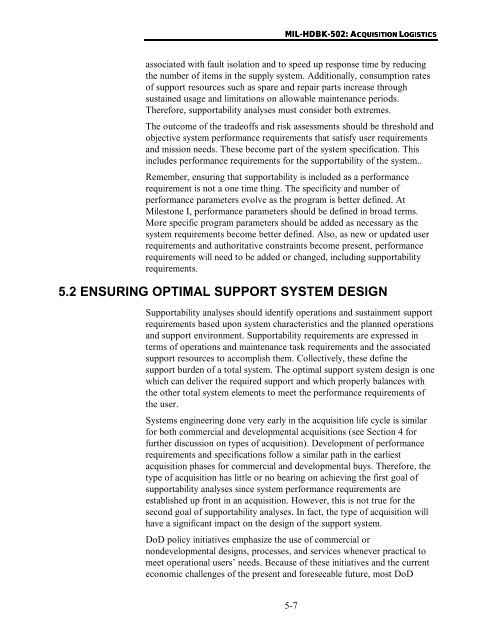MIL-HDBK-502 - Barringer and Associates, Inc.
MIL-HDBK-502 - Barringer and Associates, Inc.
MIL-HDBK-502 - Barringer and Associates, Inc.
You also want an ePaper? Increase the reach of your titles
YUMPU automatically turns print PDFs into web optimized ePapers that Google loves.
<strong>MIL</strong>-<strong>HDBK</strong>-<strong>502</strong>: ACQUISITIONALOGISTICSassociated with fault isolation <strong>and</strong> to speed up response time by reducingthe number of items in the supply system. Additionally, consumption ratesof support resources such as spare <strong>and</strong> repair parts increase throughsustained usage <strong>and</strong> limitations on allowable maintenance periods.Therefore, supportability analyses must consider both extremes.The outcome of the tradeoffs <strong>and</strong> risk assessments should be threshold <strong>and</strong>objective system performance requirements that satisfy user requirements<strong>and</strong> mission needs. These become part of the system specification. Thisincludes performance requirements for the supportability of the system..Remember, ensuring that supportability is included as a performancerequirement is not a one time thing. The specificity <strong>and</strong> number ofperformance parameters evolve as the program is better defined. AtMilestone I, performance parameters should be defined in broad terms.More specific program parameters should be added as necessary as thesystem requirements become better defined. Also, as new or updated userrequirements <strong>and</strong> authoritative constraints become present, performancerequirements will need to be added or changed, including supportabilityrequirements.5.2 ENSURING OPTIMAL SUPPORT SYSTEM DESIGNSupportability analyses should identify operations <strong>and</strong> sustainment supportrequirements based upon system characteristics <strong>and</strong> the planned operations<strong>and</strong> support environment. Supportability requirements are expressed interms of operations <strong>and</strong> maintenance task requirements <strong>and</strong> the associatedsupport resources to accomplish them. Collectively, these define thesupport burden of a total system. The optimal support system design is onewhich can deliver the required support <strong>and</strong> which properly balances withthe other total system elements to meet the performance requirements ofthe user.Systems engineering done very early in the acquisition life cycle is similarfor both commercial <strong>and</strong> developmental acquisitions (see Section 4 forfurther discussion on types of acquisition). Development of performancerequirements <strong>and</strong> specifications follow a similar path in the earliestacquisition phases for commercial <strong>and</strong> developmental buys. Therefore, thetype of acquisition has little or no bearing on achieving the first goal ofsupportability analyses since system performance requirements areestablished up front in an acquisition. However, this is not true for thesecond goal of supportability analyses. In fact, the type of acquisition willhave a significant impact on the design of the support system.DoD policy initiatives emphasize the use of commercial ornondevelopmental designs, processes, <strong>and</strong> services whenever practical tomeet operational users’ needs. Because of these initiatives <strong>and</strong> the currenteconomic challenges of the present <strong>and</strong> foreseeable future, most DoD5-7
















